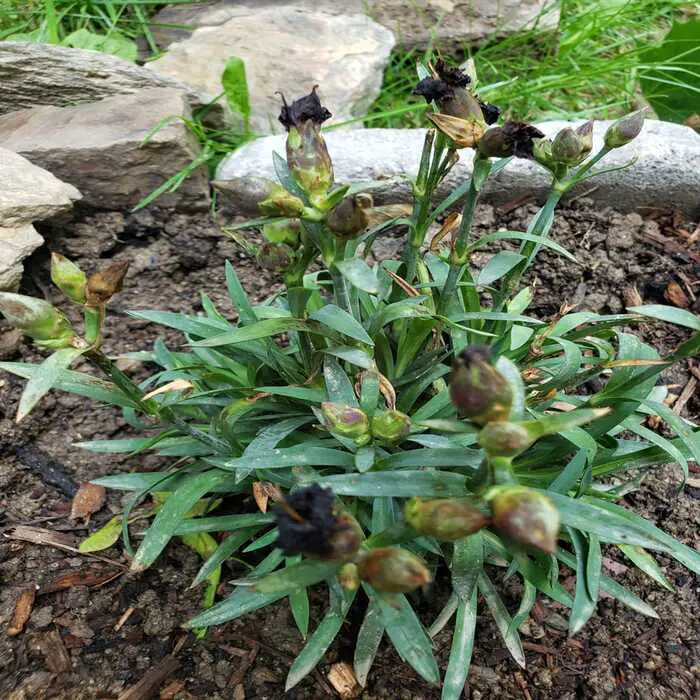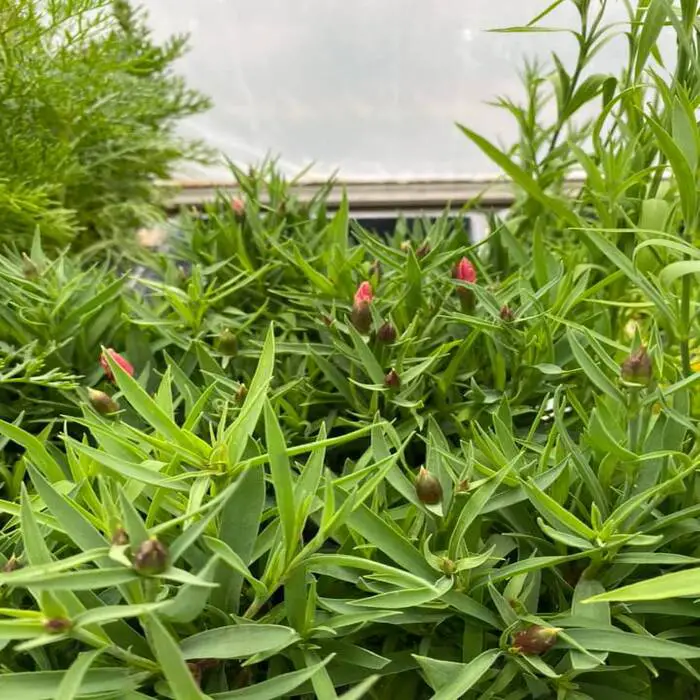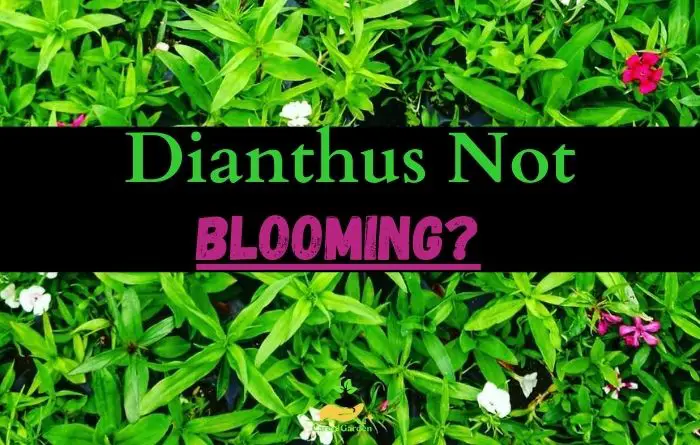Dianthus Not Blooming? Here’s What You Need To DO!
Are you feeling disappointed because your Dianthus plants aren’t blooming as expected? Don’t worry you’re not alone! In this blog post, we’ll explore the reasons why your Dianthus may not be blooming and provide you with helpful tips and tricks to get those vibrant flowers back in full swing.
Lack of sunlight, nutrient deficiencies, improper pruning techniques, pests and diseases, and extreme temperatures can all prevent Dianthus from blooming. To get those vibrant flowers back, make sure to deadhead regularly, fertilize with a balanced formula, and provide proper sunlight and water.
Reasons Why Dianthus Plants Are Not Blooming
1.Lack of Sunlight
Proper blooming of Dianthus plants heavily relies on sunlight. For these plants to thrive and showcase their flowers, they need at least 6 hours of direct sunlight every day.
Sunlight plays a role, in facilitating photosynthesis, the process through which plants produce food. Insufficient sunlight can delay the production of food for Dianthus plants, affecting their growth and ability to bloom healthily.
Shorter daylight periods, such as those experienced in fall and winter, can trigger some Dianthus varieties to enter a period of dormancy, where blooming is reduced or halted.
Insufficient sunlight can hinder blooming in Dianthus plants in many ways. Firstly, it can result in stems, stunted growth, and fewer flowers.
Secondly, it may cause the plant to develop long, slender stems with a number of leaves and blooms—what is commonly known as “growth. Lastly, inadequate sunlight can make the plant more susceptible to pests and diseases.
Solution
To ensure the blooming of your Dianthus plants, it is crucial to provide them with sunlight. If your garden lacks sun exposure, consider planting Dianthus in a container that can be easily relocated to a spot.
Additionally, trimming plants that obstruct the sun’s rays will enable your Dianthus to receive the amount of sunlight, for optimal blooming.
2.Nutrient Deficiencies

Nutrient deficiencies can significantly impact the blooming capability of Dianthus plants. These deficiencies occur when essential nutrients required for the plant’s growth and development are insufficient or unavailable in the soil.
Each nutrient plays a vital role in various processes within the plant, including flower production. When Dianthus experiences nutrient deficiencies, it struggles to allocate resources towards blooming, resulting in reduced or non-existent flower production.
| Nutrient | Function in Dianthus | Effect of Deficiency |
|---|---|---|
| Nitrogen (N) | Key component of chlorophyll | Reduced chlorophyll production, weak and pale foliage, limited energy for flowering |
| Phosphorus (P) | Involved in energy transfer | Poor flower development, limited flower production |
| Potassium (K) | Enzyme activation, water uptake | Reduced flower production, weak stems |
| Iron (Fe) | Essential for chlorophyll synthesis | Yellowing leaves (chlorosis), weak and stunted growth |
| Magnesium (Mg) | Component of chlorophyll, enzyme activation | Interveinal chlorosis, poor flower development |
| Calcium (Ca) | Cell division, flower structure | Deformed flowers, tip burn in petals |
| Boron (B) | Movement of sugars, bud initiation | Poor flower bud formation, fewer blooms |
| Zinc (Zn) | Plant hormone regulation, bud development | Delayed or abnormal flower bud development, reduced flowering |
https://www.clemson.edu/undergraduate-studies/media/NS4.pdf
https://gardentabs.com/fertilizer-helps-flowers-bloom/
One common reason for Dianthus plants not blooming is a shortage of phosphorus. This nutrient is crucial for flower development and its deficiency can result in fewer stems and fewer flowers. Signs of phosphorus include stunted growth, dark green leaves and poor blooming.
Similarly, a nitrogen deficiency can also impact the blooming of Dianthus plants. Nitrogen is essential for foliage growth. An excess amount can lead to lush foliage at the expense of blooming. Symptoms of nitrogen deficiency include yellowing leaves and impaired growth.
Solution
To prevent deficiencies and encourage flowering in Dianthus plants, it’s important to use a well-balanced fertilizer that provides all the necessary nutrients.
Using a fertilizer with a high phosphorus content promotes blooming, while one with a high nitrogen content supports foliage growth.
Additionally, incorporating compost into the soil improves its fertility. Serves as a source of nutrients, for the plants. By ensuring supply you can enjoy the splendid blooms of your Dianthus plants.
3.Incorrect Pruning or Deadheading Techniques

Improper pruning methods can hinder the blooming of Dianthus flowers. If excessive plant material, including flower buds is removed during pruning, it may lead to a decrease in the number of flowers produced. Moreover, pruning at this time of year can result in the removal of buds that would have blossomed in the season.
For instance, if Dianthus plants are pruned while they are blooming, it can reduce flower production. Cause harm to the remaining blooms. Pruning during a season can also eliminate buds that would have given rise to flowers in the season.
Proper pruning and deadheading techniques are important to encourage continuous blooming in Dianthus plants. Deadheading, which is the removal of spent flowers, promotes the growth of new flowers and prevents the plant from putting energy into producing seeds.
Solution
Hence it is crucial to utilize techniques and prune Dianthus plants at the appropriate time of year to foster healthy growth and abundant blooming.
When conducting pruning activities, make sure to use clean pruning shears and trim dead or dying dianthus parts. Pruning should be carried out in spring or early summer before the plant initiates bud formation for the season.
4. Extreme Temperatures
Extreme temperatures, whether hot or cold, can have an impact on the flowering process of Dianthus plants.
When temperatures soar these plants can experience stress leading to growth and diminished blooming. In fact, under hot conditions, Dianthus plants may produce flowers or even halt their flower production entirely.
Moreover elevated temperatures can cause the plant to droop and become more vulnerable to pests and diseases.
Conversely, low temperatures also influence the flowering process of Dianthus plants. When it gets too chilly, these plants might enter a phase where they cease producing flowers.
Additionally, freezing temperatures can induce stress in the plant. Make it more susceptible to pests and diseases.
| Temperature Range | Dianthus Blooming Response |
|---|---|
| 50°F to 75°F (10°C to 24°C) | Optimal blooming temperature range. Dianthus typically blooms prolifically within this range. |
| Above 75°F (24°C) | Blooming may decrease or slow down. High temperatures can cause stress, affecting blooming performance. |
| Below 50°F (10°C) | Blooming may decrease or stop. Low temperatures can induce dormancy, halting flower production. |
Solution
Therefore, it’s crucial to keep an eye on temperature changes and provide care for your Dianthus plants during extreme conditions. In times of scorching heatwaves, ensuring water supply and shade will help keep them cool.
Similarly, when faced with freezing temperatures safeguarding them from frostbite while providing insulation is vital, for keeping them warm.
By offering this tender care and attention, you’re enabling your Dianthus plants to thrive while enhancing your surroundings with their blossoms.
5. Overwatering
Excessive watering can result in the development of root rot a disease that negatively affects the roots of plants. When Dianthus plants receive water, the soil becomes saturated, depriving the roots of necessary oxygen. Consequently, this creates an environment, for root rot to thrive.
Root rot can stop Dianthus from blooming in many ways. Firstly, it damages the roots, leading to growth and a decrease in flower production.
Secondly, it causes the leaves to turn yellow or brown, giving the plant an unappealing appearance. Lastly, it renders the plant more susceptible to pests and diseases.
Solution
To prevent overwatering and subsequent root rot it is crucial to water Dianthus plants when the top inch of soil is dry. This ensures that the soil remains adequately moist without becoming waterlogged.
Furthermore, using draining soil and ensuring drainage for container-grown plants are essential steps. Additionally, refrain from watering the leaves of the plant, as this encourages fungus growth.
6.Pests and Diseases
Pests and diseases can wreak havoc on Dianthus plants, significantly affecting their ability to bloom and thrive. Two common culprits that often trouble Dianthus are aphids and powdery mildew.
Let’s explore how these pests and diseases can hinder blooming and ways to identify and combat them effectively.
1. Impact of Aphids on Dianthus Blooming: Aphids are tiny, sap-sucking insects that can infest Dianthus plants. They pierce the plant’s tender tissues and feed on its sap, depriving it of essential nutrients.
The consequences of an aphid infestation include:
- Stunted Growth: Aphids can cause stunted growth in Dianthus by disrupting the flow of nutrients within the plant.
- Distorted Flowers: Infested buds and blooms may appear deformed or fail to open properly, leading to reduced blooming.
- Sticky Residue: Aphids excrete a sticky substance called honeydew, which attracts mold and fungus, further affecting the plant’s health.
2. Impact of Powdery Mildew on Dianthus Blooming: Powdery mildew is a fungal disease that affects Dianthus and other plants. It appears as a white, powdery coating on the leaves and stems.
The impact of powdery mildew on Dianthus includes:
- Reduced Photosynthesis: The powdery coating on leaves interferes with photosynthesis, leading to decreased energy production and blooming limitations.
- Weakened Foliage: As the disease progresses, infected leaves may become yellow and wither, weakening the plant overall.
- Premature Flower Drop: Infected plants may shed flowers prematurely due to the weakening effects of the disease.
Solution
- Use Insecticidal Soap: For aphid control, use insecticidal soap, a safe and effective solution. Spray the affected areas, including the undersides of leaves, to dislodge and eliminate the aphids.
- Promote Good Sanitation: Regularly remove fallen leaves and debris from around Dianthus plants to reduce the risk of disease development and pest harborage.
- Practice Proper Watering: Avoid overhead watering, as wet foliage can encourage powdery mildew. Instead, water at the base of the plant to keep the leaves dry.
- Apply Fungicides: If powdery mildew becomes severe, apply a fungicidal spray to protect the plant and prevent further spread.
How to Keep Dianthus Blooming
To encourage your Dianthus to bloom, there are steps you can follow:
- Regularly remove the spent flowers (deadhead) to stimulate the growth of blooms and prevent the plant from using its energy to produce seeds. Make sure to do this throughout the growing season, for flowering.
- Provide nutrients by using fertilizer that contains essential elements like nitrogen, phosphorus and potassium. This will support blooming in your Dianthus. You can choose a fertilizer with higher levels of phosphorus, for blooming or higher levels of nitrogen for healthier foliage growth.
- Practice methods to promote blooming in your Dianthus plants. By removing any dying parts, you’ll encourage growth and more abundant blossoms. Take care not to prune, as it may result in no flowering at all.
- Ensure that your Dianthus receives sunlight and water for growth and blooming. These plants need at 6 hours of sunlight daily to develop vibrant flowers and lush foliage. Additionally, avoid overwatering or underwatering, as both can negatively impact growth and blooming potential. Water the plant when the top inch of soil feels dry.
Conclusion
In conclusion, Dianthus not blooming can be due to improper pruning, pests, diseases, and extreme temperatures.
Remember to deadhead regularly, fertilize appropriately, provide proper sunlight and water, and prevent pests and diseases. With these tips and tricks, you’ll have your Dianthus blooming beautifully in no time.
Frequently Asked Questions
This can happen due to various factors. One approach is to try rejuvenation pruning. Cut back your Dianthus to a few inches above the soil level, and it may encourage new growth and blooming. Also, ensure you are providing adequate sunlight and proper care.
To keep your Dianthus blooming throughout the season, practice regular deadheading. Remove faded flowers to prompt the plant to produce more blooms. Additionally, ensure proper sunlight, fertilize as needed, and address any pest or disease issues promptly.
To keep Dianthus blooming all summer, provide at least 6 hours of direct sunlight, deadhead spent flowers regularly, water consistently, and fertilize with a balanced formula. Proper care and attention will ensure continuous blooming throughout the season.
The time it takes for Dianthus to rebloom can vary, but it typically occurs within a few weeks to a month after the initial blooming period. Regular deadheading can encourage quicker reblooming by stimulating the production of new flower buds.




